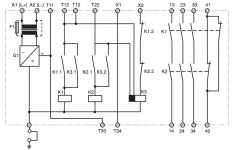I hadn't used my DMC63V for awhile and when I powered it up I get axis errors as soon as I try to enable the 24V (HH426 control). I have all the documentation but the E-Stop chain is ver obscure and complicated. It involves a PILZ PNOZ1 and a PILZ PZE5V8 expansion along with about 13 other (mostly Seimens) relays in series. There is also feedback through the control and through the axis drive.
In trying to understand what is wrong, I've been looking at the PILZ relays. Their documentation is really bad, and these are wired nothing like the rudimentary examples given. Nor is it explained how the basic function even works. Does anyone know?

The documentation says:
What do they mean by "X1 - X2 and T33 - T34 are bridged"? By wire? By an E-Stop button? X1, T33, and T34 are Not Connected in my circuit, it looks like those are a reset function.
In my circuit, there is a short loop through the E-Stop buttons and a couple of relay contacts which would short T11 to T12 (which is bridged to T22). A much longer series of contacts from T11 to X2 which any number of conditions would break. The symbol used for the K3 coil is very confusing to me - the black box at the end connecting to T12 and T22 seems to be the key - how does that work?
I think the problem is that the 22 relays in the cabinet are suspect, all 20 years old and somewhat contaminated by coolant mist. When I measure the resistance across contacts, I find some can be very flakey. I am considering replacing the lot of them, costs about $2000, but without pinpointing the problem I may just be flushing $2000 for nothing - they need replacing, but if I can't otherwise fix the machine then a waste.
In trying to understand what is wrong, I've been looking at the PILZ relays. Their documentation is really bad, and these are wired nothing like the rudimentary examples given. Nor is it explained how the basic function even works. Does anyone know?

The documentation says:
Which is somewhat less than crystal clear. What energizes K3? shorting T11 and T12 (or T11 and T22)? And then if X2 has 24V it will stay energized? Or does it require 24V on X2 to energize K3?When the operating voltage is supplied,
X1 - X2 and T33 - T34 are bridged and the input circuit is closed, relay K3 energises.
• Input circuit closed (e.g. Emergency Stop
Button not activated): Relays K1 and K2 energise via the N/O K3.1 and K3.2 and latch via K1.1/K2.1. The status indicators illuminate. The safety contacts (13-14/23- 24/33-34) are closed, the signal contact (41-42) is opened.
• Input circuit opened (e.g. Emergency Stop Button activated): K1 and K2 de-energise. The safety contacts (13-14/23-24/33-34) are opened redundantly, the signal contact (41-42) is closed.
What do they mean by "X1 - X2 and T33 - T34 are bridged"? By wire? By an E-Stop button? X1, T33, and T34 are Not Connected in my circuit, it looks like those are a reset function.
In my circuit, there is a short loop through the E-Stop buttons and a couple of relay contacts which would short T11 to T12 (which is bridged to T22). A much longer series of contacts from T11 to X2 which any number of conditions would break. The symbol used for the K3 coil is very confusing to me - the black box at the end connecting to T12 and T22 seems to be the key - how does that work?
I think the problem is that the 22 relays in the cabinet are suspect, all 20 years old and somewhat contaminated by coolant mist. When I measure the resistance across contacts, I find some can be very flakey. I am considering replacing the lot of them, costs about $2000, but without pinpointing the problem I may just be flushing $2000 for nothing - they need replacing, but if I can't otherwise fix the machine then a waste.


